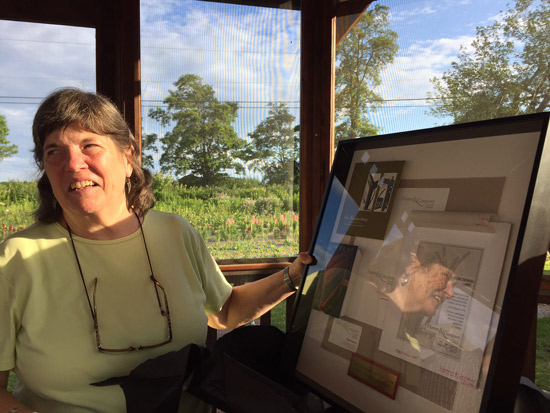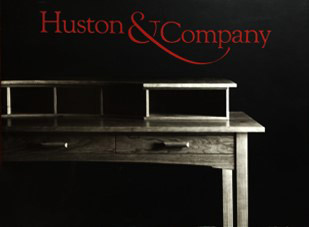In late 1987, when Bill Huston decided to open his own business as a custom furniture builder, his sister, Jill, a graphic designer, offered to create a logo and some mock-ups of marketing materials that Bill could take to the bank to procure his first business loan. From that day on Jill was Huston & Company’s sole graphic designer; creating every catalog, every postcard, every advertisement and every printed marketing tool for the company for 27 years. The logo she created in 1987 is the same iconic logo – with its long sweeping ampersand – we use today.
In the fall of 2014, Jill decided to retire from her design career and handed the graphic reins of Huston & Company to a new designer.
We recently celebrated Jill’s incredible contribution to Huston & Company, and thanked her for establishing the brand that is Huston & Company and for helping us to grow that brand over three decades.
At a small, private dinner, Bill presented his sister, Jill, with a shadowbox featuring some of her earliest designs for Huston & Company, along with some of her latest.

Jill Bock
Jill recently shared her story with me…
When did you decide on graphic design as a career? Where did you study? Who were your first clients?
In the small town where I grew up in Yellow Springs, Ohio, there was a well known national graphic designer, Reid Viemeister, who had moved there from New York City with his family. During high school I became interested in design, and he offered me the chance to work at his small graphic design studio during my summer breaks.
As a result, I decided the only place I would apply to was to an art school, and decided that it would be the Rhode Island School of Design (RISD) and amazingly… I got in! When we selected majors, I picked graphics. After a year, however, I really wanted to switch to textile design… and I did.
When I graduated, I was awarded a Textron scholarship to study anywhere abroad for a year. I picked Printed Textile design at the Central College of Art in London. While there, I started working freelance and had a job at the end of the year designing printed fabrics for a fashion textile company in London.
My work in textiles and parts of the fashion industry in England lasted 13 years and I then returned to the U.S… and Ohio. It was clear that I couldn’t expect to find good design work in the textile/fashion industry in the U.S. at the time I returned, unless I moved back to either the New York City or South Carolina areas. So… back in Yellow Springs, I returned to Graphics. Reid, the owner of the local Vie Design Studio, where I had worked summers, offered me a job so I moved back into graphics… where I stayed.
Graphic design, as an industry and art-form, has changed very dramatically throughout your career. What were some of the changes in your craft or the changes you had to make as a designer that you liked, and which ones did you not like?
Yes, graphics has changed greatly during my years in the business….
I now look back at working on mock-ups for clients as perhaps a kind of an art-form. I loved making hand drawings and hand-made mockups of a design for logos, brochures, ads and booklets such as annual reports, which I was so well trained to do at Vie Design—they were so essential to sell a design to the client.
Now, everything can be presented to the client in life-size color images produced from a software program on the computer.
On the production side….
To prepare a graphic piece, such as a catalog, to be printed by a printer is so much different now than when I first began in graphics. Earlier you had to layout boards for all of the pages of the piece to be printed for sending to the printer. You would then paste down into position linotype sheets with rubber cement and later with wax. You would then hand draw in the position for the placement of the photos and other graphic elements by the printer, etc.
Now, just about everything is created and executed electronically from concepts to press runs. It certainly requires a totally different mindset… from start to finish.
How difficult was it to adjust to the technical changes in the design field as they came about?
Well, I can’t say that I have always loved some of the changes in software and they can make for challenges which often add frustration and time to working on projects… but I do like checking-out the new ideas.
Bill has said that it was you who convinced him to study abroad when he was enrolled at Beloit College, thus leading him to furniture making and his lifelong career. Do you remember that? And what was it that caused you to urge him to do so?
I don’t really remember actually pushing him, but since I know what a difference it made for me to have the experience to live and work and learn abroad, I can imagine really urging him to go. It made such a difference in my design ability! It obviously made a difference for him, too, as can be seen in his wonderful designs and work!
You created all of the design work for Huston & Company from the company’s inception in the spring of 1988 until the fall of 2014. You designed the company logo and helped to visually establish the brand right from day 1. Your designs were instrumental in securing the initial loans, even, for the start of the business. You created every ad, every postcard, every brochure and catalog for Huston & Company for over 26 years. Do you have a favorite ‘piece’ from that huge collection?
I love the black and white catalog we did in 1991 with the varnished black & white photo of the Hall Table on the cover with the varnished “Huston & Company” logo in rust color. Its dramatic simplicity and elegance set the tone for what was to come.

And now you have a fairly large collection of Huston & Company furniture in your home! Do you have a favorite piece from THAT collection?
I love all of the many pieces I have of Bill’s and now Saer’s furniture, but I especially love the Coat Tree because it involved our whole family—Bill designed it and figured out the wood fittings, brother Bob made the cast iron base at the family gray iron foundry in Ohio, and I got to design the promotional card for the Coat Tree. It was a Huston Family “labor of love”.
As you pass the torch, so to speak, to a new designer, what would you like to pass along? What are your hopes for the brand that you have helped to create and make so successful? What elements of your design do you hope will continue to thread through into future design work for Huston & Company?
Since the furniture is already so elegant, my hope for ongoing graphic design is for “simplicity.” Let the furniture shine through!
I couldn’t be more proud of what my “little brother” has accomplished, and couldn’t feel more lucky to have participated in his wonderful woodworking success.
~~